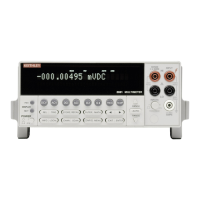IEEE-488 Reference
4-74
:PASS:SOURce <NRf>
:CALCulate3:PASS:SOURce <NRf> Specify “pass” pattern
Parameter <NRf> = 0 to 15 Specify digital pattern for output port
Format :calc3:pass:sour <NRf>
Defaults Power-up Saved power-on setup
*RST 0
:SYSTem:PRESet 0
Query :SOURce? Query programmed source value
Short-form format: :calc3:pass:sour?
Response message: 0 to 15
Description This command is used to specify which line(s) of the Digital Output Port will go true when there
are no failures in the limit tests.
Each output line is assigned a decimal weight as follows:
Digital Output Decimal Weight
Line #1 1
Line #2 2
Line #3 4
Line #4 8
The parameter value for the digital pattern is determined by adding the decimal weights of the
desired output lines. For example, if you want output lines #2 and #3 to go true when all enabled
limit tests pass, use a parameter value of 6 (2+4).
The actual true state (high or low) of each Digital Output line depends on its programmed po-
larity. If programmed for active-high polarity, the output line will go high (true) when all enabled
limit tests pass. If programmed for active-low polarity, the output line will go low (true) when
all enabled limit tests pass. Polarity is programmed from the Output subsystem (see paragraph
4.17).
Note that when the binning strobe is enabled (see :BSTRobe command path), output line #4 is
not considered to be part of the digital output pattern. The binning strobe uses line #4. With the
strobe enabled, parameter values 8 through 15 are treated the same as parameters 0 through 7.
Programming example 10 OUTPUT 716; “:calc3:pass:sour 3; sour?”
20 ENTER 716; A$
30 PRINT A$
40 END
Line 10 Two commands in this program message; the first specifies output line #3 to go true
if all enabled limits pass, and the second queries the source value.
Line 20 Addresses the Model 2001 to talk.
Line 30 Displays the source value (4).

